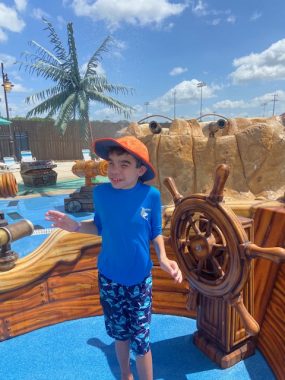Making Spaces: The Importance of Cultivating Inclusion

Summer — it’s a season of lots of fun, but also lots of difficulty for my family and many others like us.
As I wrote last month, my 11-year-old son, Will, has Sanfilippo syndrome, which makes summer a particularly tough time for me as a caregiver. In addition to losing the moments of respite that his school provides, summer leaves us missing the built-in social structure and the appropriate activities that help Will to thrive.
Will loves people and activities. At his school, we have been fortunate that he has faculty, staff, and students who love him right back, just as he is. But when we leave that protective bubble of support, it gets a little harder to navigate social settings.
Will looks a little “different,” he acts “different,” and he uses “different” equipment to get around and enjoy his day. We notice the looks, and sometimes even judgment, from others when we are out and about in public. So, one of the big challenges of summer is to continually search for spaces where Will can be accepted and included.
Inclusive spaces are important. They offer Will the engagement and interaction he craves while also giving me, as Will’s caregiver, opportunities for social interaction and support.
A third important reason is exposure — but not for Will. By finding and taking Will to inclusive spaces, he and I give others an opportunity to better learn and practice engaging and interacting with someone who has special needs.
Gaining that knowledge is essential. According to a 2019 U.S. Census Bureau brief, the childhood disability rate in this country has increased over the past decade, with over 3 million children having some type of disability. Further, an estimated 61 million adults live with a disability in the U.S. These folks need, and deserve, places where they are comfortable and accepted.

Will, 11, enjoys a day at Morgan’s Inspiration Island, an ultra-accessible theme park in San Antonio, Texas. (Photo by Valerie Tharp Byers)
What does it mean to make an inclusive space? It means being vocal and public about being accepting of all individuals. Many families aren’t comfortable enough to initially reach out, or they may not have the energy to do so. Having clear marketing about welcoming all types of people is a great first step.
It means being prepared to listen, learn, and adapt. Needs and accommodations vary significantly depending upon the individual. There must be a focus on building a strong rapport with people with chronic illness or disability and their caregivers to hear what is really needed. Then there must be follow-through to meet those needs. Making quality spaces takes time.
It means receiving training about appropriately engaging with people with special needs or disabilities. Discussions about topics like alternative communication methods, behavior management, proper language, and accessibility are vitally important.
It means arranging appropriate small and large group spaces. Inclusive spaces ensure that participants have engaging experiences that are relevant to them while also ensuring that they feel like full and valued members of the overall community.
It means acknowledging and valuing the work people with disabilities and their families do to get to these spaces, and asking for their feedback and continued partnership. The plot twist to finding an inclusive space is that oftentimes, it is difficult to participate due to travel needs, schedule changes, new stimuli, significant amounts of crucial personal care items, and other factors. Inclusive spaces show gratitude for participation.
We are fortunate to have found a few summer camps and an ultra-accessible theme park that have made these types of spaces for Will to attend, engage, and enjoy. These spaces don’t necessarily provide me any rest or respite. At camps, I attend as his aide, due to his significant needs and the training time that would be necessary to educate someone else to take on those roles.
Further, the amount of packing and prepping for any out-of-the-ordinary adventure is significant, as is the emotional burden of continually explaining Will’s story to others and engaging with people’s well-intentioned remarks. But that’s how important I believe inclusive spaces and engagement opportunities for Will are. I’m willing to step up to the challenge if it makes my son happy, and if it offers others the opportunity to see, up close and personal, the humanity in all people.
Inclusion is everyone’s responsibility, and everyone benefits from it. When people take the time to get to know Will, they nearly always find a way to connect with him. They discover that he isn’t all that “different” from them, and they can take that knowledge forward, cultivating empathy, meaningful social change, and maybe even more inclusive spaces.
***
Note: Sanfilippo News is strictly a news and information website about the syndrome. It does not provide medical advice, diagnosis, or treatment. This content is not intended to be a substitute for professional medical advice, diagnosis, or treatment. Always seek the advice of your physician or other qualified health provider with any questions you may have regarding a medical condition. Never disregard professional medical advice or delay in seeking it because of something you have read on this website. The opinions expressed in this column are not those of Sanfilippo News or its parent company, Bionews, and are intended to spark discussion about issues pertaining to Sanfilippo syndrome.







Leave a comment
Fill in the required fields to post. Your email address will not be published.